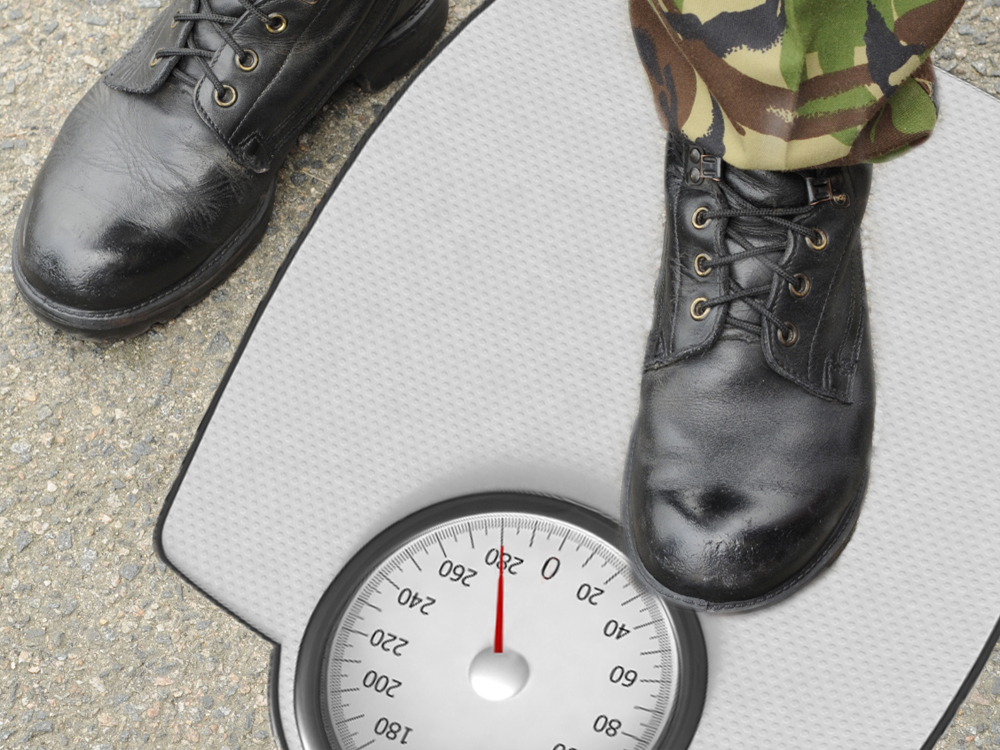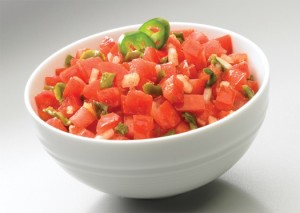September 23, 2015
September 21, 2015
Monday Total Cardio Workout With Carol Strom Day 10 of 21 day challenge.
August 31, 2015
March 24, 2012
Army Steps Up Efforts to Get New Troops Fit
Shape Up, Soldier!
Soldiers can still find pancakes on the chow line at the U.S. Army’s Fort Leonard Wood training facility in Missouri. But now they’re made with whole-grain batter — adding more fiber and protein.
The new focus on nutrition is part of a ‘Fueling the Soldier’ initiative that aims to teach soldiers to make healthier choices during military training and in combat.
“The Army must treat our soldiers as tactical athletes to improve not only physical training but also trying to get them to adapt the right nutritional aspects to help prepare them for the battlefield and for their life,” Lt. Gen. Mark Hertling said in a statement.
Hertling is overseeing an overhaul of physical readiness training. In fact, the Army is tossing out the old training manuals, and taking a new approach to basic training.
Gone are the long endurance runs, which officials say can lead to injuries in new recruits who aren’t accustomed to the mileage.
Instead, soldiers will be coached by trainers to do a whole range of exercises that build core strength, flexibility and endurance. Training will be tailored to a soldier’s level of fitness.
A new cafeteria Fort Leonard Wood was also unveiled today. As soldiers walk down the cafeteria line, they see foods marked with red, yellow or green labels.
Green marks high-performance foods, and posters nudge the soldiers to “Go For Green” frequently.
In addition, the cooks have turned off fryers and started baking more entrees. They’re also adding lots of ‘nutrient-dense’ menu options made from fresh food.
To help reinforce these messages, drill sergeants will give one-hour courses in “performance nutrition.” Maybe Shots can invite them over for dinner with our kids?
Why the change in approach? Well, army recruits mirror the general population, which is trending toward the ‘heavier’ side—to put it politely.
More than 9 million Americans of prime recruiting age are too heavy to join up, according to Mission: Readiness, a group of retired senior military officials pushing for better fitness for young people.
Enlisted men and women are no exception. A 2008 Department of Defense survey found that 38 percent of people enrolled in the military health system were overweight or obese.
The new training plan incorporates physical therapists and sports trainers at the unit level to promote proper techniques and injury prevention
If you’d like to see how the Army is putting its soldier-as-athlete model into action, you can download a free iPhone app called “Army Physical Readiness Training.” It was developed by programmers at the U.S. Army Center of Excellence at Fort Gordon, Ga.
The Army plans to make the changes at its other training installations in Fort Sill, Okla.; Fort Benning, Ga.; Fort Jackson, S.C.; and Fort Knox, Ky. in the coming months
—
Original Article from NPR Health
March 22, 2012
Hot Salsa Tip
Did you know that salsa has surpassed ketchup as America’s favorite condiment? Salsa can spice up all kinds of bland meals. Stir in a jar of your favorite salsa to add some zing to a pot of kidney, white, pinto, red or black beans; then top with a dollop of sour cream for a unique, high-fiber side dish.
June 3, 2011
Copy your Cat!
|
June 1, 2011
Got culture?
Got culture? Museums, theaters and concert halls may be the ticket to a happy, healthy life

People who attended concerts, went to museums, and engaged in cultural activities in general were happier and healthier in a recent study. (Luis Sinco/Los Angeles Times)
The secret to a healthy, happy life may be found at an art gallery, movie theater or concert hall. (It might even be in church, a baseball stadium or gym.) At least if you live in Norway.
A study of more than 50,000 Norwegian men and women found that those involved in cultural activities — either “receptive” activities like attending a concert or a baseball game or “creative” ones like playing in a band or working out — were more likely to be satisfied with their lives and to say they were in good health. They were also less likely to experience anxiety or depression.
The particular activities that made a difference were a little different for men and women. For instance, women who attended sporting events were more likely to report being in “good” or “very good” health. For men, involvement with anyreceptive cultural activity, including visiting a museum or going to the theater, was linked with “good” or “very good” perceived health.
With regard to depression, both men and women had lower scores if they participated in clubs, outdoor activites or worked out. Women also had lower scores if they went dancing, and men also had lower scores if they were involved in music, singing or theater.
Generally speaking, the more people engaged in various cultural activities, the better their scores:
“In both women and men, a dose-response effect was indicated,” the researchers wrote. “The frequency of cultural particpation and the number of different activities were positively associated with good health, SWL (satisfaction with life), a lower anxiety score and a lower depression score.”
Of course, people who earn more money were more likely to take part in both receptive and creative cultural activities. And it’s well known that people with higher incomes are also more likely to be healthy. But the researchers found that a link between cultural partipation and health that was independent of socioeconomic status.
April 15, 2011
7 Breakfast Foods to Swap In, Not Out
Is breakfast really the “most important” meal of the day? Maybe, at least that’s what they told us in health class.
So if breakfast is the first meal of the day and you’re trying to lose weight, it’s probably a smart idea to make your first meal a good one.
And since most dieters judge food by two simple factors: fat and calories. Here are seven foods you should ditch and seven foods you should switch to if you’re looking for a better breakfast.
English Muffin or Bagel?

Sorry, but a bagel with a schmear of cream cheese just isn’t Kosher – at least not for dieting. You’re better off switching to toasted nooks and crannies dripping with melted butter.
*English Muffin, with butter
5.8g total fat
189 calories
Bagel, with cream cheese
8g total fat
436 calories
Apple or Banana?

Let’s face it, both apples and bananas are awesome – probably the healthiest foods on this list – but, if you’re looking to cut calories, go with the apple.
*Apple
0.17g total fat
50 calories
Banana
0.33g total fat
100 calories
Blueberry Yogurt or Oatmeal?

Even without the “probiotics,” eating a light yogurt is smarter than a bowl of old fashioned oatmeal.
*Dannon Light’n Fit Blueberry Yogurt (6oz)
0g total fat
80 calories
Old Fashioned Quaker Oats, with water (1/2 cup)
3g total fat
150 calories
Coffee with Skim Milk or 2% Milk?

For most people, missing their morning coffee is grounds for murder. So please, drink up! But make sure you stick with non-fat milk, not 2%
*Starbucks Coffee, with non-fat milk (short)
0g total fat
35 calories
Starbucks Coffee, with 2% milk (short)
2g total fat
50 calories
Wheaties or Raisin Bran?

One cereal uses professional athletes to push product. Another is peddled by the sun. The sports stars win, go with a bowl of Wheaties.
*Wheaties (1 cup)
1g total fat
110 calories
Raisin Bran (1 cup)
1.3g total fat
190 calories
Turkey Bacon or Pork?

It isn’t real bacon – it might not even taste like it – but the fat and calories don’t lie. Spare a pig, eat a turkey!
*Butterball Bacon-Style Turkey (1 slice, 18g)
3g total fat
40 calories
Pork Bacon (3 slices, 19g)
7.9g total fat
103 calories
Grapefruit Juice or Orange Juice?

Grapefruit juice might not taste as sweet, but choke it down. It’s better than orange juice. And when you drink grapefruit juice, it’s less likely to squirt in your eye.
*Tropicana Grapefruit Juice (8 fl oz)
0g total fat
90 calories
Tropicana Orange Juice (8 fl oz)
0g total fat
110 calories
April 12, 2011
Does Dieting Make You Angry And Stressed?
 The idea of reaching for a stick of celery when all you really want is a big slice of chocolate cake, would probably make most people a little grumpy.
The idea of reaching for a stick of celery when all you really want is a big slice of chocolate cake, would probably make most people a little grumpy.
And, according to results published in the Journal of Consumer Research, exerting self-control while dieting can in fact make people feel angry and irritable.
The researchers set up four experiments to compare the attitudes of volunteers who were on a diet, with those who ate what they wanted. They found that:
- Participants who choose an apple over a bar of chocolate were more likely to choose movies which had angry, revenge-filled plots.
- Those who choose a gift certificate for groceries rather than one for a spa service, showed more interest in looking at angry faces as opposed to more fearful ones.
- And, in an other experiment, people who chose a healthy snack instead of a less healthy one were more irritated by a public service advert promoting exercise.
Interestingly, the researchers have linked these feelings of irritation, stress, and anger to the act of exerting self-control while dieting, rather than the “dieting” itself.
The researchers point out that public policy makers should be more aware of the potential negative emotions, which can result when the public are encouraged to exert more self control over their daily choices.
What about you — does being on a diet make you feel more irritated or angry? How do you make healthy food choices without feeling like you’re denying yourself?
—
Article Courtesy from: diet-blog
Image courtesy by: Kreutziana
April 8, 2011
“Vegetarian” Diets Reduce Heart Risks
 Eating a meat-free diet may lower your risk of developing heart disease, suggests a new study, helping to lessen the likelihood of metabolic syndrome.
Eating a meat-free diet may lower your risk of developing heart disease, suggests a new study, helping to lessen the likelihood of metabolic syndrome.
Metabolic syndrome is a collection of diseases that contribute to cardiovascular disease, including diabetes, obesity, and high blood pressure.
Researches found vegetarians had better blood sugar, blood fat, blood pressure, waist size, and body mass measurements than non-vegetarians.
In the study, 23 out of every 100 vegetarians were found to have at least three metabolic syndrome factors, compared with 39 out of every 100 non-vegetarians and 37 out of every 100 semi-vegetarians.
For the study, published in the journal Diabetes Care, scientists analyzed the diet of three different groups of people: vegetarians, non-vegetarians, and semi-vegetarians; in total, more than 700 adults.
The researchers used a questionnaire to obtain information on participants’ eating habits. People were classified as vegetarian, eating meat less than once a month; semi-vegetarian, eating meat less than once a week; and non-vegetarians. However, the term “vegetarian” is incorrectly defined; true vegetarians never eat meat.
Results showed vegetarians had an average body mass index (BMI) of 25.7. Unlike non-vegetarians who had an average BMI close to 30. Semi-vegetarians’ BMI fell between the vegetarians and non-vegetarians.
A BMI between 25 and 29 is considered overweight and a BMI from 30 and up is obese. Normal weight is between 18.5 and 25.
The findings remained steady when researchers combined all the readings to determine the risk of metabolic syndrome.
In 2008, Vegetarian Times reported that 7.3 million Americans follow a vegetarian diet: 59% are female, 41% are male. As of 2009, the total U.S. population was nearly 308 million.
According to the American Heart Association, a vegetarian diet – with its heavy vegetable consumption and low intake of saturated fat from animal products – has been shown to reduce the risk of heart disease, heart attack, obesity, high blood pressure, and some forms of cancer.
Article courtesy from diet-blog
Image courtesy from first reason blog







